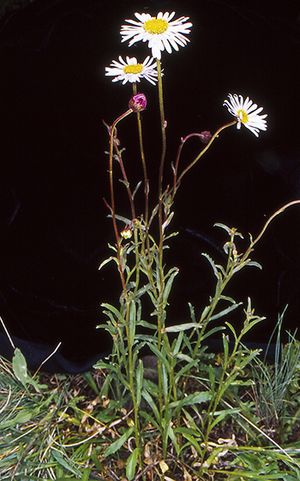Hill daisy facts for kids
Quick facts for kids Hill daisy |
|
|---|---|
 |
|
| Scientific classification | |
| Kingdom: | |
| (unranked): | |
| (unranked): | |
| (unranked): | |
| Order: | |
| Family: | |
| Genus: |
Brachyscome
|
| Species: |
B. aculeata
|
| Binomial name | |
| Brachyscome aculeata (Labill.) Less.
|
|
The Brachyscome aculeata, commonly called the hill daisy, is a beautiful plant found only in Australia. It's a type of herb that grows in clumps and lives for many years. You can easily spot it by its white, daisy-like flowers, which usually have a bright yellow center. This plant typically blooms from spring through autumn.
What the Hill Daisy Looks Like
The Hill daisy is a herb that grows with branches reaching about 20 to 60 centimeters tall. Its stems are covered with leaves.
The leaves can be smooth or have small hairs. Lower leaves are often shaped like a spear, wider at the top, or narrow and rounded. They are usually 2 to 9 centimeters long and 5 to 15 millimeters wide. Their edges are mostly smooth, but sometimes they have small teeth or lobes. The leaves higher up on the stem are smooth-edged and narrow.
The flowers are white, but sometimes they can be pink. They look like daisies and are about 4 centimeters wide, with a yellow center. There are 12 to 20 special leaf-like parts called bracts around the flowers. These bracts are arranged in rows and are about 5 to 8 millimeters long.
After flowering, the plant produces small, dry fruits. Each fruit has one seed and is egg-shaped, about 3 to 3.5 millimeters long. The surface of these fruits can be smooth or slightly bumpy. Hill daisies usually flower from October to April.
How the Hill Daisy Got Its Name
This plant was first given a scientific name, Bellis aculeata, in 1806 by a scientist named Jacques Labillardière. He wrote about it in his book, Novae Hollandiae Plantarum Specimen.
Later, in 1832, another scientist named Christian Friedrich Lessing changed its name to Brachyscome aculeata. He published this new name in his work, Synopsis Generum Compositarum. The second part of its scientific name, aculeata, comes from a Latin word. It means "prickly" or "sharp-pointed."
Where the Hill Daisy Grows
In New South Wales, the hill daisy grows in dry areas. You can find it in the southern tablelands, from Wingello all the way to Kosciuszko National Park.
In Victoria, this plant is mostly found in the eastern part of the state. It often grows in wet places, including the Grampians region. It can also be found at higher altitudes, but it rarely grows in open grassy fields there.

